Substance abuse and addiction continue to be significant concerns on a global scale, impacting millions of lives and presenting complex challenges for healthcare systems. While it’s crucial to recognize that addiction is a multifaceted issue influenced by a variety of factors, some substances have properties that make them particularly addictive. This blog aims to explore the most addictive drugs known to mankind, based on their chemical makeup, addictive properties, and the severity of their withdrawal symptoms.
The Neurochemical Perspective on Addiction
Addiction isn’t merely a matter of willpower or moral failing; it has its roots in neurochemistry. Neurotransmitters like dopamine, serotonin, and endorphins play pivotal roles in shaping addictive behavior. Drugs that cause significant surges in these neurotransmitters can result in intense cravings and compulsive consumption, making them highly addictive.
Opioids: The Powerhouse of Addictiveness
The opioid class of drugs, which includes substances like heroin, morphine, and prescription painkillers like OxyContin, is notoriously addictive. These drugs interact with opioid receptors in the brain to provide pain relief and produce a sense of euphoria. However, they also suppress natural endorphin production, making individuals dependent on the substance for pleasure and pain relief. Withdrawal symptoms can be severe, contributing to high relapse rates.
Cocaine: A Stimulant With A Grip
Derived from the coca plant, cocaine is a powerful stimulant that leads to intense but short-lived highs. It exerts its effects by inhibiting the reuptake of dopamine, leading to elevated mood and feelings of grandiosity. The intense high is followed by a significant low, triggering a cycle of repeated use to stave off negative emotions. The withdrawal can be psychologically grueling, involving depression, fatigue, and increased appetite.
Nicotine: The Subtle Invader
While not as immediately lethal or socially stigmatized as some other substances, nicotine, commonly found in tobacco products, has a high addiction potential. Its addictive properties can be attributed to its ability to stimulate the release of dopamine, enhancing mood and concentration. Withdrawal symptoms include irritability, difficulty concentrating, and cravings, making it challenging for users to quit.
Alcohol: The Socially Accepted Addictive Substance
Alcohol operates by depressing the central nervous system, leading initially to lowered inhibitions and feelings of relaxation. However, it also disrupts the balance of neurotransmitters, affecting mood and judgment. Heavy and chronic use can lead to severe withdrawal symptoms, including delirium tremens, which can be fatal if not medically managed.
Benzodiazepines: The Double-Edged Sword
Benzodiazepines like Valium and Xanax are often prescribed for anxiety and insomnia but have a high potential for abuse. They work by enhancing the effects of the neurotransmitter GABA, inducing a calming effect. Withdrawal can lead to severe symptoms like seizures, increasing both the risk and fear of cessation.
Methamphetamines: The All-Consuming Stimulant
Methamphetamines dramatically increase the release of dopamine, leading to intense feelings of pleasure. However, this also results in severe depletion of dopamine levels, causing withdrawal symptoms that include extreme fatigue and depression.
Conclusion
The potential for addiction varies from substance to substance, influenced by their interaction with neurotransmitters and the severity of withdrawal symptoms. Understanding the addictive properties of these drugs provides a foundation for grappling with the complexities of substance abuse and addiction, underlining the necessity for medically informed intervention strategies.





